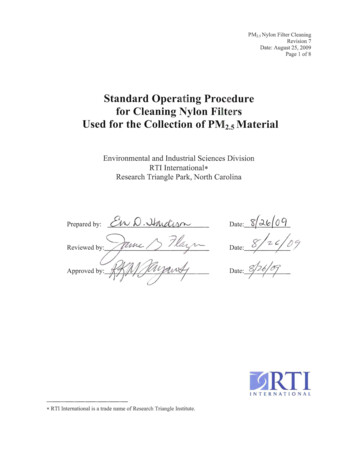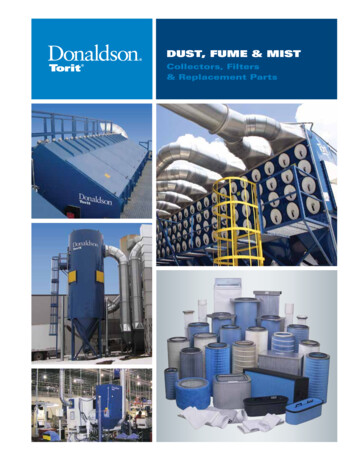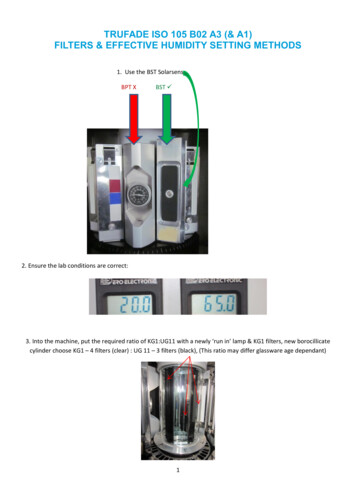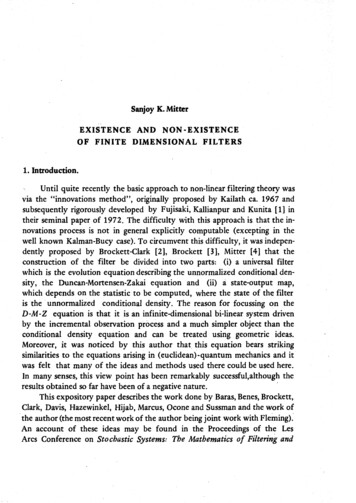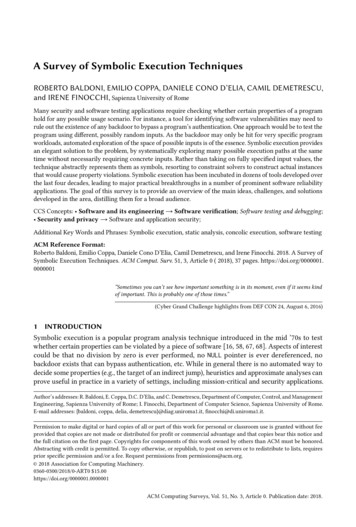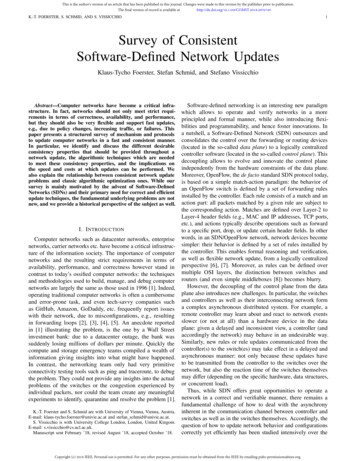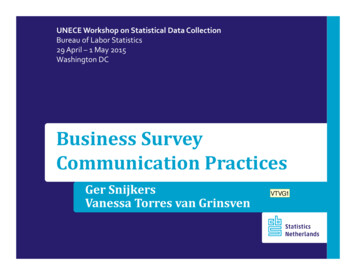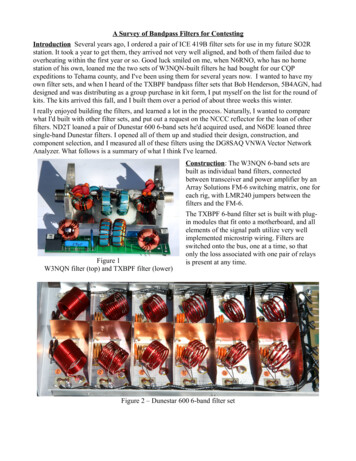
Transcription
A Survey of Bandpass Filters for ContestingIntroduction Several years ago, I ordered a pair of ICE 419B filter sets for use in my future SO2Rstation. It took a year to get them, they arrived not very well aligned, and both of them failed due tooverheating within the first year or so. Good luck smiled on me, when N6RNO, who has no homestation of his own, loaned me the two sets of W3NQN-built filters he had bought for our CQPexpeditions to Tehama county, and I've been using them for several years now. I wanted to have myown filter sets, and when I heard of the TXBPF bandpass filter sets that Bob Henderson, 5B4AGN, haddesigned and was distributing as a group purchase in kit form, I put myself on the list for the round ofkits. The kits arrived this fall, and I built them over a period of about three weeks this winter.I really enjoyed building the filters, and learned a lot in the process. Naturally, I wanted to comparewhat I'd built with other filter sets, and put out a request on the NCCC reflector for the loan of otherfilters. ND2T loaned a pair of Dunestar 600 6-band sets he'd acquired used, and N6DE loaned threesingle-band Dunestar filters. I opened all of them up and studied their design, construction, andcomponent selection, and I measured all of these filters using the DG8SAQ VNWA Vector NetworkAnalyzer. What follows is a summary of what I think I've learned.Construction: The W3NQN 6-band sets arebuilt as individual band filters, connectedbetween transceiver and power amplifier by anArray Solutions FM-6 switching matrix, one foreach rig, with LMR240 jumpers between thefilters and the FM-6.Figure 1W3NQN filter (top) and TXBPF filter (lower)The TXBPF 6-band filter set is built with plugin modules that fit onto a motherboard, and allelements of the signal path utilize very wellimplemented microstrip wiring. Filters areswitched onto the bus, one at a time, so thatonly the loss associated with one pair of relaysis present at any time.Figure 2 – Dunestar 600 6-band filter set
The Dunestar 6-band set has individual filterspermanently mounted to a motherboard withminiature RG-174-size coax between the filters andthe relay-controlled bandswitch matrix. Cable shieldsare carried between filters and relays, but not betweenthe relay matrix and chassis-mounted SO239connectors.The ICE 419B has six filters mounted to a singleboard, and the signal path is carried in series throughrelays that either bypass or switch the filter into thecircuit.Figure 3 – Dunestar 600 RF SwitchinOne of my two ICE 419B filter sets had a bad relay for the 80M filter that failed to make good contactuntil hit with TX power; after hitting it with TX power it passed signal on receive. Anecdotal reportsfrom users noted that the ICE owner (now SK) advised drilling a hole in the cover of the relay andspraying the relay with DeOxit, and my 419Bs came with that hole drilled. I did that with the 80Mrelay, and when I tried to measure that box, learned that all of the relays were flaky, and ended upspraying all of them. Even after multiple sprayings, operation remains erratic.Figure 4 – ICE 419B 6-band Filter SetBypass Mode: If, like me, you operate 6M using a SteppIR, you might be concerned with how theswitching matrix behaves in bypass mode. Performance is shown in the table.Filter Set50 MHz Attenuation50 MHz VSWRArray Solutions FM6-0.3 dB1.29:1Dunestar 600-0.17 dB1.09:1TXBPF-0.08 dB1.16:1ICE 419BToo erratic to measure (see text)
The TXBPF filter set, (at right), hasindividual filter modules that plugonto a motherboard. Blackrectangles near the left side of thephoto are the bypass relays; thesignal path between them ismicrostrip, and RG58, both centerand shield, are wired to Amphenolflange-mount SO239 connectors.The result is excellent bypassperformance on 6M, the best of allpackages measured. A band decoderand buffered relay drivers to switchexternal antenna relays is on adaughterboard mounted verticallybehind the rear panel (at left in thephoto).Figure 5 – TXBPF Filter SetFigure 6 – TXBPF (above), Dunestar 600 (center), 10M W3NQN-built filter (below)
Note: The photos of Figures 6 and 7 were intentionally taken with the filter sets very close together sothat their relative sizes, and the sizes of their components, can be compared. Figure 7 – ICE 419B (top)and Dunestar 600 (lower) Filter SetsFilter Designs: The Dunestar filters are 2-pole designs, with tapped input and output resonator coils(connected as an auto transformer) to step up the filter impedance to a level where higher circuit Qs canbe realized. The W3NQN-built filters and the TXBPF filters are 3-pole designs, also with tappedinductors as transformers, use of powered iron cores for most of the inductors, improving their Q, andby making those input and output windings tri-filar or quadra-filar, which improves transformercoupling. The filters in the ICE 419 are simple 2-pole filters with small, un-tapped, air core inductors.The 5B4AGN-designed TXBPF filters stick pretty closely to the designs published by W3NQN in hisQST article. But like most highly creative people, W3NQN has continued to grow, and most of theW3NQN-built filters include nice modifications to his published designs that improve rejection ofadjacent bands, generally at some sacrifice to rejection on other bands. Where the TXBPF filters andW3NQN-built filters differ, this is the primary reason.Components and Power Ratings: All of the filter sets tested are nominally rated for CW or SSBoperation at 200W PEP. Dunestar says that their filters should de-rated for RTTY operation, withoutsaying how much, and this is good advice for all of the filters. These ratings imply low SWR at thepoint where the filter is inserted at the output of the transceiver – certainly under 2:1 – and dissipationwithin the filter can easily increase, potentially to destructive levels, with significant mismatch. Many
(most?) ham power amps can be driven to full power with 50 watts of drive, so filters actually builtwith components to justify the 200W rating should hold up well. The greatest stress on the filter occursduring a 100W contest, when the rig drives the antenna directly, and even greater when the SWR ishigh. See the reliability reports, later in this report.It's always been true that careful component selection is critical to building reliable, high quality RFgear. I first learned this working as an EE student at RL Drake. Bob Drake taught me that “if you wantto build filters and radios, you've got to wind all your own coils.” Bob Henderson, 5B4AGN, reportsthat “Alas the generic deep red mica caps, which mostly originate in India these days have a higherthan desirable ESR due to the presence of iron. These are mostly realistically rated at 500V with onlylimited preferred values available rated at 1kV. These caps are good for many RF purposes but not sogood with power.” Most of the caps in the ICE filters are “deep red micas.”ICE filter sets utilize 1kV-rated capacitors for the lower frequency band filters, but only 500V caps forthe higher frequency filters. Capacitors in the Dunestar filters whose ratings I could identify are 1kVrated, and all but a few have NPO temperature stability ratings. Except for the 160M filters, all areceramics. The W3NQN and TXBPF filters are the best built by far, very well designed, and usinginductors and capacitors capable of handling the output of a 100W transceiver. They do this by usingcapacitors with higher voltage ratings and lower ESR (equivalent series resistance), and by windinginductors on larger cores, and on core materials best suited to the application. The TXBPF kits areshipped with excellent close tolerance, conservatively-rated SBH-series capacitors made by TabComponents in the UK, specifically intended for use in HF transmitting filter applications. They're notcheap – 90 for the 18 caps needed for one 6-filter set. http://www.tabmica.co.uk/page3.htmlReliability: W3NQN-built filters have an excellent record for reliability. About the only way to fry oneis to run it on the wrong band or in a system with high SWR, perhaps due to antenna failure. Anecdotalreports, mostly solicited on the PVRC and NCCC email reflectors, indicate that Dunestar and ICEfilters for the higher bands, especially 15M and 10M, are prone to failure, nearly always one of the lowcost ceramic capacitors in the input and output resonator circuits. A few ICE 419 and Dunestar 600users have reported failure of a single relay, but especially in the Dunestar unit the problem does notseem to be widespread. The poor power handling of ICE filters is well known, and, in my judgment,they should never be used in a 100W contest barefoot, or at more than the 50W needed to drive mostamplifiers. Some Dunestar users suggest that the 300 and 600 filters hold up OK at 100W CW andSSB, but RTTY at this level can cause failures. Owners of these filters might do well to rebuild thehigher band filters with SBH capacitors from Tab Components. It could be tricky fitting them into theavailable space, and some realignment would be required with any capacitor replacement.Alignment: All of these filters are aligned by squeezing or stretching the spacing of turns on the inductors while watching a swept response on a spectrum analyzer or VNA. It's a learned skill and it canbe a bit tedious to get it right, but serious effort is rewarded with lower VSWR and in-band attenuation,and increased reliability.Rejection of AM Broadcast Signals: The Dunestar, TXBPF, and W3NQN-built 160M filters allprovided good rejection of AM broadcast signals, nearly as good as the dedicated ICE BCB filter, andthe W3NQN and TXBPF filters for higher bands are far better. 160M filter rejection at 1 MHz was-47dB for the Dunestars, -39 dB for the ICE 419s, and -42dB for the TXBPF and W3NQN-built sets.Rejection of the ICE BCB filter is -58.5dB at 1 MHz. With any of these filters, you're far less likely toneed a dedicated AM broadcast filter unless you've got a close-in neighbor above about 1300 kHz.Insertion Loss: Insertion loss is a function of both filter design and alignment – a filter that is out ofalignment will have greater insertion loss than the same filter properly tuned. Taking circuit complexityinto account, filters using powdered iron cores tend to have lower insertion loss than those using aircore inductors, especially on the lower HF bands. As a group, the W3NQN and TXBPF filter sets havethe lowest insertion loss. Dunestar and ICE filters use air core inductors, Dunestar filters have
relatively high insertion loss on lower bands and the highest insertion loss overall, but fairly goodattenuation performance. The ICE filters have fairly low insertion loss (partly because they are thesimplest filters), but the poorest attenuation, because they are the simplest filters.Attenuation Performance: There are several ways to view the attenuation curves. Looking at overallattenuation outside the passband, the W3NQN filters rank first, the TXBPF set second, the Dunestarfilters a notch below them, and the ICE 419B filter set a very distant fourth. But there's anotherimportant perspective – attenuation on the first adjacent bands, since that's how we contest most of thetime. Studying adjacent band performance, the differences are surprising. Some filters that rate poorlyfor overall suppression outside the passband are superior performers on the first adjacent band! Note,for example, the superior 160M suppression of the Dunestar 80M filter, the 80M suppression of the40M Dunestar, the 15M suppression of the 20M Dunestar, the 10M suppression of the 15M Dunestar.With few exceptions, the W3NQN-built individual band filters have the best adjacent band suppression,thanks to refinements to his designs after publication of his QST article on filters. Depending on thearrangement of your antennas and the coupling between them under various operating scenarios, youmay choose one set of filters over another.Executive Summary and Recommendations: If cost is no object and you don't have the time or skillsto build your own, the W3NQN-built filters distributed by Array Solutions, with the addition of one ofthe several switching matrices Array Solutions offers, are the best performers. The two filter sets Itested were very well built and aligned. Approximate cost of the package I tested – six filters, the FM-6switching matrix, and Elecraft KRC2 band decoder, is about 1100 (plus tax and shipping).The Dunestar 600 is second best of the “ready built” filter sets, which, with a KRC2 band decodercosts about 600 (plus tax and shipping). Overall performance is a good notch below the W3NQN-builtfilters, at about one half the cost, but their narrower bandwidth yields excellent adjacent bandsuppression. Insertion loss tends to be high, especially on the lower bands, the 160M, 80M, and 10Mfilters cover only the lower half of those bands, and alignment of the two filter sets I tested could havebeen better (possibly because these filters have a lot of hours on them in a contesting station). This isimportant, because these filters are much narrower than all others tested.The TXBPF filter set, which includes a band decoder and buffered relay driver in a package about thesame size as the Dunestar set, costs about 420 (tax and shipping included), yields performance thatfalls between the individual W3NQN-built filters and the Dunestar 600, at about one third the cost ofthe W3NQN set and about 200 less than the Dunestar 600. The TXBPF's only weak spots aresomewhat inferior adjacent band performance of a few higher band filters on non-harmonically relatedbands (for example, 15M rejection of the 20M and 10M filters, 10M rejection of the 15M filter). Counton spending about 40 hours to build and align each set of six filters. You'll be winding a lot of coils,doing a a fair amount of surface mount soldering, putting the well designed package together, andaligning the filters. I really enjoyed this project, and learned a lot from it.A
photo are the bypass relays; the signal path between them is microstrip, and RG58, both center and shield, are wired to Amphenol flange-mount SO239 connectors. The result is excellent bypass performance on 6M, the best of all packages measured. A band decoder and buffered relay drivers to switch external antenna relays is on a
